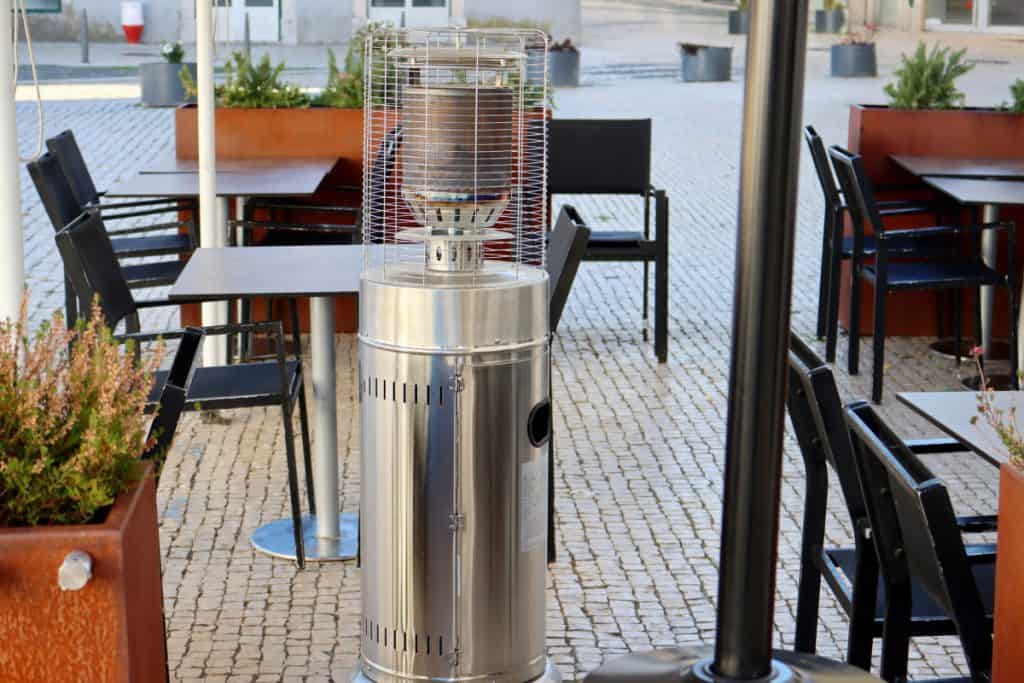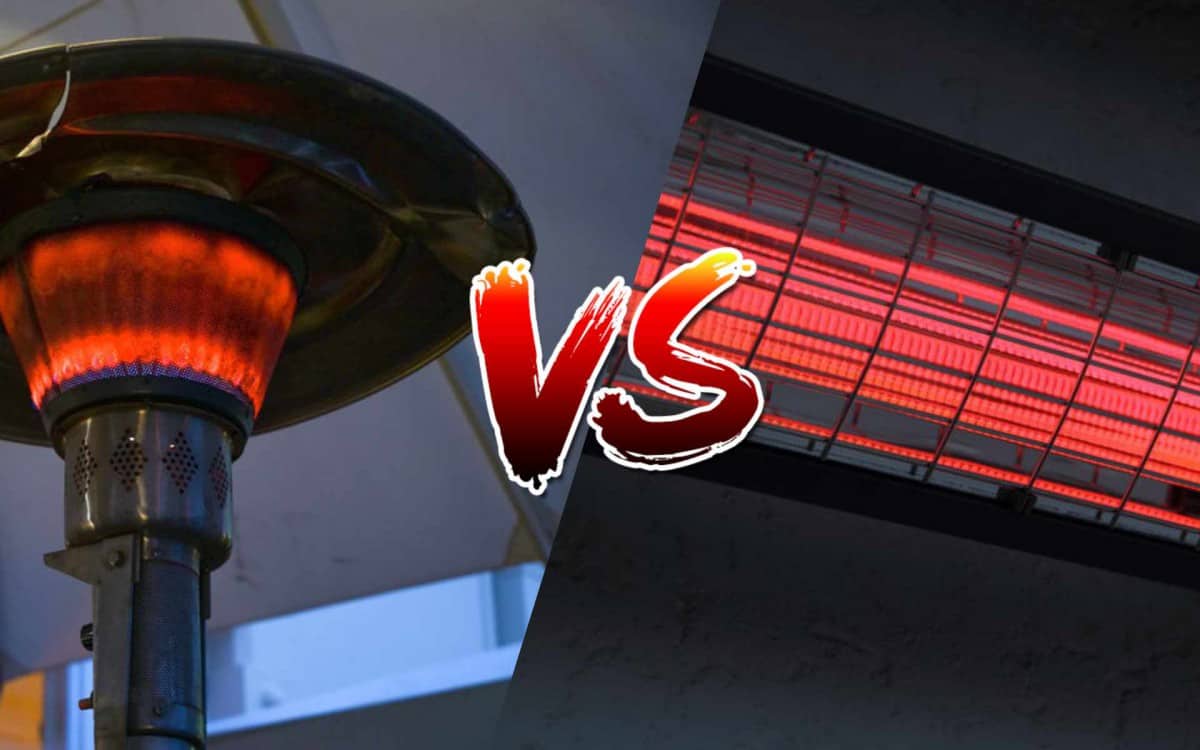With more homeowners than ever before making the decision to purchase outdoor patio heaters, gaining more livable space without having to spend a fortune on renovations, finding the right unit becomes mission priority number one.
Unfortunately, the biggest problem folks have when searching for a patio heater is not that there are so few worthy options to choose from but that there are so many!
Not only do you have a bunch of different brands offering a bunch of different types of patio heaters, but you also have different heating technology to consider, too.
Below we breakdown the major differences between propane patio heaters and those that use infrared technology, helping to shine a light on which one might make the most sense for you going forward.
Let’s get into it!
The Benefits and Drawbacks of Infrared Heating

Infrared heating works similar to the way that the sun does, warming you with invisible rays of light that you feel the moment that they start to come in contact with you.
Your body absorbs this energy, starts to warm up, and all of a sudden you feel like you are swimming in sunshine when your back patio is being heated with this technology.
At the same time, there are definitely some drawbacks to using infrared solutions – and we highlight those a little more in depth in just a moment.
For now, though, let’s get into what we really like about infrared heating patio technology.
Instant and On Demand Heat
To kick things off, the fact that infrared heaters are literally “instant on” heating solutions are game changers – particularly when you are talking about heating up space outdoors.
Sure, you might have 15 or 20 minutes to wait for a propane heater to power up and start to warm up a space in the spring or fall.
But what if you are looking to enjoy some outdoor time in the middle of winter and definitely can’t afford that kind of delay?
What if you want to be able to throw your patio heater on immediately and warm up while you dry off after sliding out of the swimming pool?
What if you just want to take the chill out of your bones with a quick flash of heat before you jump inside?
That’s where infrared technology really shines. You’ll start to feel its warmth immediately and on demand as soon as you flip that switch.
Very Quiet Operation
Another big benefit of infrared heating technology is that it is so impossibly quiet.
Every heat source is going to generate at least a little bit of noise, but the noise coming out of infrared heaters is next to nothing. In fact, the only thing that you are really going to hear are the coils themselves as they start to reach temperature.
You don’t have to worry about loud fans (there aren’t any), you don’t have to worry about loud combustion engines (there isn’t one), and you don’t have to worry about loud flame sources or blowers, either.
Now, you’ll get almost whisper quiet heating on demand and instantaneously after you flip the switch – perfect for outdoor spaces where you don’t want to have to talk over your heating source!
Next to No Maintenance Needed
There are not a lot of maintenance protocols you’ll have to move through when you have infrared heaters responsible for keeping things toasty outside, mostly because there are next to no moving parts in these systems to begin with.
The lack of moving parts means that there is a lot less friction, a lot less wear and tear, and a lot less rubbing between different materials that can cause them to degrade performance over time.
No, your infrared heater is going to work just as well 10 years from now as it does today provided that it is kept out of crazy weather conditions and really (REALLY) extreme temperatures.
All you really have to do is clean the infrared reflectors every now and again (usually when you think about it) and you’ll be doing enough maintenance to keep your infrared heater running at top efficiency.
That being said, it’s time to dig a little deeper into the not so hot features of infrared technology.
Can Pose a Safety Risk
For starters, infrared heating coils can get really – REALLY – hot in a hurry.
It’s important that you keep kids and pets away from these kinds of units when they are on. It doesn’t take a whole lot to tip them over in most circumstances, and the last thing you want is for someone to get hurt or burned because of direct contact with infrared heating elements.
It’s not a bad idea to invest in emergency tip over switches and automatic shut offs with these kinds of heaters, just to keep people safe.
Heat Stops the Second You Turn the Heater Off
Because these do not really radiate heat all over the place, instead sending infrared waves directly to your body to warm you up specifically, you’re not going to notice the space around you get that warm.
Not only that, but you’ll immediately notice a significant temperature drop the second that you turn the heater off.
These are very much “active” heating units as opposed to “passive” heating units. That’s something you’ll want to be aware of for sure.
The Benefits and Drawbacks of Propane Heating

Propane heating units have a bunch of benefits themselves, making them worthy contenders for a space on your back patio for sure.
Low Cost of Ownership
The low overall cost of ownership with these kinds of heaters is definitely a bonus.
Sure, these units can (often) be a little more expensive than every other kind of heating unit out there upfront. But when you compare overall cost of ownership over its lifetime the numbers staggeringly favor propane units.
You’re going to save a bundle of money if you choose to go in this direction.
Safe and Easy to Use
Propane heaters are also very safe, very efficient, and very easy to use.
The odds are pretty good that you either have a propane grill or have used a propane grill in the past, and you may even have a propane set for a camp stove or in your kitchen!
The reason that propane is such a popular heating sources because of how safe and easy it is to use. The fuel source itself is very stable, super portable, and convenient to use the technology needed to fire propane is very simple and straightforward, too.
Available in an Unlimited Amount of Configurations
It’s impossible to overlook the versatility of propane patio units, especially from a design and output standpoint.
Because propane is so flexible and easy to work with people using this fuel source can come up with all kinds of heating systems, styles, and designs that are not going to be negatively impacted by any limitations put on them by propane itself.
Instead, there’s a lot of creative freedom here.
This produces propane heating units that are short and compact, tall and wide, uniquely designed to match the aesthetic and architecture of your outside spaces – and that’s just the tip of the iceberg!
Of course, there are some drawbacks to moving forward with propane patio heaters, too.
Higher Cost Upfront
As we highlighted a moment ago, propane heaters are almost universally more expensive than pretty much every other type of patio heater on the market today – at least at first.
Not only are you going to have to purchase the heater itself, but you’re also likely going to have to purchase propane fuel tanks, propane fuel lines, and other safety features that you might not have had to purchase with an infrared set up, for example.
Negatively Impacted By the Wind
Another struggle people are going to have with propane based patio heaters is that they are often negatively impacted with even just a little bit of wind.
It really doesn’t take much to blow out the light on a propane heater, and once that happens you’re going to have to re-fire the unit – and hope that it doesn’t blow out again right away.
This can get really annoying and tedious if it’s happening all the time.
Make sure that you set up your propane patio heaters near solid surfaces and walls (with about a 2 foot buffer zone, though) to act as a natural windbreak. You want to be sure that your patio heaters running off of propane aren’t exposed to huge gusts of wind all the time.
Which Patio Heater is Right for Me?
At the end of the day, there’s a lot to like with both propane and infrared patio heaters.
Propane heaters are probably a little more common, a little bit easier to use, and definitely have a lower overall cost of ownership.
That being said, it’s tough to beat on demand heating capabilities of a quality infrared unit and there’s definitely improved reliability with these kinds of systems compared to propane, too.
All in all, your budget, how you hope to use these heaters moving forward, and the technology that makes the most sense for you should be the deciding factors in your decision.
Alright guys, that’s it for this article, if you are interesting in reading more about patio heaters, we have lots of cool articles related such as:
7 Electric Patio Heater Accessories That Just MAKE SENSE!
7 Propane Patio Heater Accessories That Just MAKE SENSE!
Why do Patio Heaters Stop Working (Common & Uncommon Faults)

